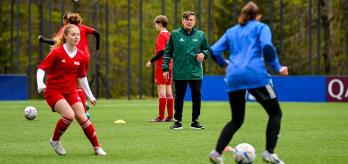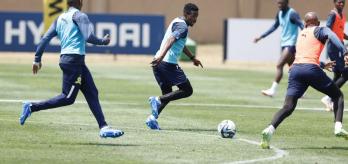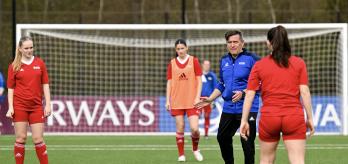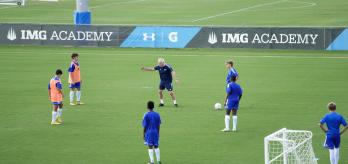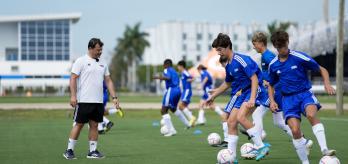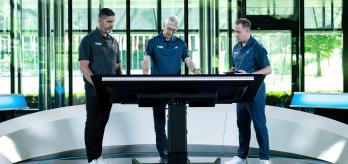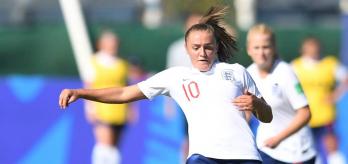When a team that sets up in a 4-3-3 system attempts to progress the ball into attack against a side that adopts a 5-3-2 formation they may encounter problems because their full-backs can easily be closed down due to the opposition's wider shape, which can leave them exposed in terms of defensive cover. As a result, it may be more effective for a team that lines up in a 4-3-3 formation to progress the ball centrally or pick out the attacking midfielders first.
In this session, former Arsenal goalkeeper and coach Jens Lehmann provides a series of exercises that focus on progressing the ball into the final third effectively when playing in a 4-3-3 system against a side that adopts a 5-3-2 set-up. The session starts with a possession game that gives players the opportunity to work on their spatial awareness, sharpness of passing and moving the ball out of congested areas. The next exercise sees the players work on their movement patterns in an 11v11 game played on a full-size pitch, before the session is rounded off with an 11v11 game on a smaller pitch.
Session overview
Key coaching points
This session requires 20 outfield players and 2 goalkeepers.
-
Players on the attacking team should avoid passing to their full-backs in their own half as the opposition can lock on and press aggressively, which can leave them exposed if possession is lost.
-
The front 3 attacking players should stay high up the pitch and pin the opposition defenders back.
-
When building from the back in a 4-3-3, the midfielders should adopt high starting positions to draw the opposition away, which will create space for them to come short and receive the ball from their centre-backs.
-
The centre-backs should play on different lines to each other so that they can offer passing angles that make it easier to play through pressure.
-
If one flank is congested, players should look to switch the play quickly and take advantage of the space on the opposite side of the pitch.
-
By adopting synchronised and well-timed movements, the players will be able to create the space and time to play precise passes.
This session was designed with specific real-game situations in mind. When setting up in a 4-3-3 system and playing against a 5-3-2 formation, the ball needs to be progressed into specific areas to be moved forward successfully.
Part 1: Pre-session tactical meeting
Before the players take to the field, Jens prepares them for the session with a visual breakdown of each exercise and the necessary actions in order to carry out the exercises successfully.
Part 2: possession game – 5v5 plus goalkeeper
This first exercise gives the players the chance to hone their passing skills and move the ball quickly. Focusing on movement and passing detail will help the players to be efficient when they find themselves in overload scenarios.
-
Mark out two 20x30-metre areas.
-
Divide the players into teams of 5.
-
Organise a 5v5 set-up in each area.
-
Add a goalkeeper in each area.
-
The objective for each team is to keep possession for as long as possible within the area.
-
The team out of possession tries to win the ball.
-
The goalkeeper supports the team in possession at all times to create a 6v5 scenario.
-
All players are limited to 3 touches each.
-
Increase the size of the playing area to 30x30 metres.
-
Reduce the number of touches per player to 1.
-
The player who wins the ball is allowed 2 touches.
-
Players must display spatial awareness at all times and scan their surroundings to allow them to find the space to receive a pass.
-
Players should read and predict the movement of team-mates and opponents to allow them to react accordingly.
-
By maintaining intelligent distances between team members, the team in possession should be able to move the ball successfully and make the best use of the area.
-
By adopting synchronised and well-timed movements, the players will be able to create the space and time to play precise passes.
-
It is important that players maintain constant and clear communication throughout the drill to help their team-mates to identify the best areas in which to move the ball.
Part 3: 11v11 – movement patterns in a 4-3-3 v. 5-3-2
This 11v11 game focuses on the ability of the team that sets up in a 4-3-3 system to overcome their opponents in a 5-3-2 formation. The fact that the two formations are systematically different offers players opportunities to build from the back whilst encountering contrasting presses.
-
Use a full-size pitch.
-
Set up the attacking team in a 4-3-3 formation.
-
Set up the defending team in a 3-5-2 formation.
-
Put a goalkeeper in each goal.
-
The attacking team tries to build from the back and go on to score.
-
The defending team sets up in a high block and tries to gain possession.
Variation 1
-
The attacking team plays out from the back unopposed (no press).
Variation 2
-
The defending team applies a high press in an attempt to break down the attack.
Variation 3
-
The defending team still applies pressure, but begins the exercise by dropping into a mid-block.
-
The team building from the back should try to avoid playing the ball to the full-backs inside their own half as this allows the defending team to lock on and press aggressively.
-
Recycle possession, rather than trying to play risky and hopeful long balls. Use the goalkeeper if necessary.
-
Central midfielders are required to make coordinated and intelligent runs to create pockets of space that can be taken advantage of during the build-up.
-
By adopting a high starting position, the midfielders earn themselves more space to move into and receive when coming short to collect the ball from the centre-backs.
-
During the build-up, the midfielders should always be in motion and constantly make themselves available to receive passes from the defenders.
-
When the defending team applies a mid-block, the attacking team should look to switch the ball from one side of the pitch to the other to expose the space around the central midfielders and down the channels.
Part 4: 11v11 – movement patterns in a 4-3-3 v. 3-5-2 (smaller pitch)
This final exercise continues the strategy of building from the back in a 4-3-3 formation against a 3-5-2. In this instance, space limitations are introduced for both teams so that they have to be quicker and more creative and accurate in their movement.
-
Mark out a 70x40-metre pitch.
-
Set up the attacking team in a 4-3-3 formation.
-
Set up the defending team in a 3-5-2 formation.
-
Put a goalkeeper in each goal.
-
The exercise is split into two 7-minute sequences.
-
The attacking team tries to build from the back and go on to score.
-
The defending team sets up in a high block and tries to gain possession.
-
Limit both teams to 3 touches per player for the first 7 minutes.
-
The offside rule applies in this exercise.
-
After 7 minutes of play, swap the team formations around, i.e. the defending team switches to a 4-3-3 and vice versa.
- Remove the limit on touches after the first 7 minutes.
-
Encourage the defending team to adopt a high line. The defensive line should not be too deep and the defenders should use the offside trap effectively.
-
When space is limited down one side of the pitch, the team in possession should look to switch the play quickly.
-
Avoid passing to the full-backs when they are in their own half, as this can allow the opposition to lock on and press aggressively.
-
Recycle possession, rather than trying to play risky and hopeful long balls. Use the goalkeeper if necessary.
-
The attacking players and midfielders should always look for pockets of space in which to receive the ball and allow ball progression into the final third. They can do this by taking up a high starting position and then coming short to create extra space to receive the ball.
-
All players should regain their defensive positions whenever their team loses the ball to avoid being left exposed.
















